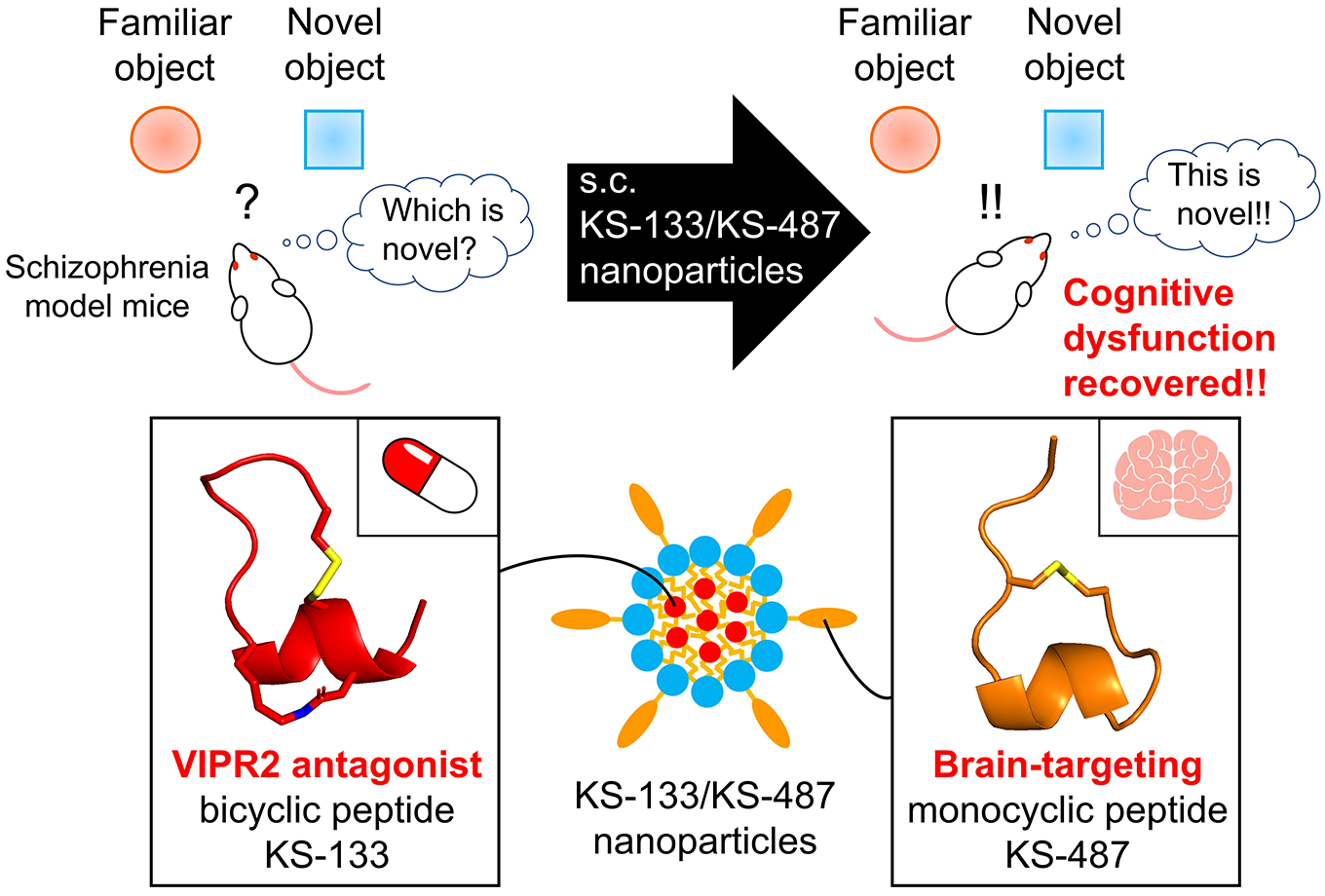Novel Peptide Formulation Shows Promise of Restoring Cognitive Decline in Schizophrenia
The nanoparticle-based drug delivery system, developed by researchers from Japan, can specifically target genetic mechanisms associated with schizophrenia
Schizophrenia is a serious mental health disorder linked to the imbalance of chemical neurotransmitters that affect cognitive capabilities. Current therapies against schizophrenia have numerous limitations, largely due to the selective permeability of blood-brain barrier, which necessitates the development of novel strategies. Advancing research, scientists from Japan Advanced Institute of Science and Technology have now developed targeted drug delivery systems using peptide-based nanoparticles, that improved cognitive decline in animal models of schizophrenia.
Schizophrenia is a complicated mental health disorder accompanied by wide range of symptoms such as hallucinations, impaired cognitive ability, and disorganized speech or behavior. It has been associated with anomalies in neurotransmission due to the imbalance of chemical neurotransmitters. Current treatment strategies against schizophrenia involve the administration of antipsychotic drugs, which can cause adverse effects and are associated with a high risk of cardiovascular disease. Moreover, in patients, response to therapeutic drugs is often inadequate as the blood-brain barrier (BBB), a protective barrier of cells, strictly regulates the movement of ions and molecules into the brain.
To overcome the hurdle of BBB and facilitate the transport of therapeutic drugs into brain tissue to treat schizophrenia, researchers have explored the applicability of receptor-mediated transcytosis (RMT) using low-density lipoprotein receptor-related protein 1 (LRP1). This research was conducted by team led by Associate Professor Eijiro Miyako from Japan Advanced Institute of Science and Technology (JAIST), included Prof. Yukio Ago from Hiroshima University, Prof. Shinsaku Nakagawa from Osaka University, Prof. Takatsugu Hirokawa from Tsukuba University, and Dr. Kotaro Sakamoto, Senior Principal Scientist at Ichimaru Pharcos Co., Ltd. Their study was published in JACS Au journal on June 20, 2024.
The researchers were inspired by previous findings which showed the interactions of vasoactive intestinal peptide receptor 2 (VIPR2) gene duplication in schizophrenia and their own discovery of a novel peptide, KS-133. The novel peptide, KS-133, has selective antagonist activity to VIPR2, leading to its downregulation. However, the major limitation associated with KS-133 was its poor permeability across BBB.
To facilitate the effective transport of KS-133 into the brain, they developed a brain-targeting peptide, KS-487, that could specifically bind to LRP1 and influence RMT. Finally, the researchers developed a novel nanoparticle-based drug delivery system (DDS) where KS-133 peptide was encapsulated with KS-487 targeting peptide and studied its efficacy in treating schizophrenia.
The administration of peptide formulations via the DDS resulted in the effective distribution of the drug in the brains of mice. Drug release profiles assessed by pharmacokinetic analysis confirmed the role of the brain-targeting peptide in transporting KS-133 into the brain. Furthermore, the efficacy of DDS was evaluated in mice with induced schizophrenia by elevated activation of VIPR2. Mice treated with KS-133/KS-487 nanoparticles showed significant improvement in cognitive functions during novel object recognition tests, which could be attributed to the inhibition of VIPR2.
Explaining the real-life applications and potential of their study, Dr. Miyako shares, "Existing drugs only have mechanisms involving neurotransmitter modulation, and their therapeutic effects are limited, especially for cognitive dysfunction. Thus, our peptide formulation could be used as a novel drug to restore cognitive dysfunction in schizophrenia."
In summary, this study by Dr. Miyako and co-researchers provides preclinical evidence of a novel therapeutic strategy for targeting VIPR2 that could improve cognitive impairment in schizophrenia. "Going ahead, we will extend our study to involve cells and animal models, as well as human clinical trials, to confirm the efficacy and safety of this peptide formulation and promote its development as a new treatment for schizophrenia within 5 years," concludes Dr. Miyako, optimistic about the long-term implications of their study.
We hope that the discovery and development of novel DDS utilizing bio-compatible peptides revolutionizes the treatment landscape of schizophrenia!
Image title: Schematic of tailored and multi-functionalized nanoparticles to treat schizophrenia
Image caption: Nanoparticle-based drug delivery systems (DDS) containing peptides offer an innovative approach to effectively treat schizophrenia. Such DDSs hold significant potential to revolutionize therapeutic strategies against diseases that affect the central nervous system.
Image credit: Eijiro Miyako from JAIST.
License type: Original Content
Usage restriction: Cannot be used without permission.
Reference
| Title of original paper: | Cyclic Peptides KS-133 and KS-487 Multifunctionalized Nanoparticles Enable Efficient Brain Targeting for Treating Schizophrenia |
| Authors: | Kotaro Sakamoto*, Seigo Iwata, Zihao Jin, Lu Chen, Tatsunori Miyaoka, Mei Yamada, Kaiga Katahira, Rei Yokoyama, Ami Ono, Satoshi Asano, Kotaro Tanimoto, Rika Ishimura, Shinsaku Nakagawa, Takatsugu Hirokawa, Yukio Ago*, and Eijiro Miyako* |
| Journal: | JACS Au |
| DOI: | 10.1021/jacsau.4c00311 |
Funding information
This work was technically supported by the Platform Project for Supporting Drug Discovery and Life Science Research (Basis for Supporting Innovative Drug Discovery and Life Science Research (BINDS)) from the Japan Agency for Medical Research and Development (AMED, JP18am0101114, JP23ama121026j0002) and Research Support Project for Life Science and Drug Discovery (BINDS) from AMED under grant numbers JP23ama121052 and JP23ama121054. Eijiro Miyako thanks the Japan Society for the Promotion of Science (JSPS) KAKENHI Grant-in-Aid for Scientific Research (A) (Grant number 23H00551), JSPS KAKENHI Grant-in-Aid for Challenging Research (Pioneering) (Grant number 22K18440), the Japan Science and Technology Agency for Adaptable and Seamless Technology Transfer Program through Target-driven R&D (Grant Number JPMJTR22U1), Institute for Fermentation, Osaka, and the Uehara Memorial Foundation. This work was partially supported by grants from JSPS KAKENHI to Satoshi Asano [23K091380] and Yukio Ago [20H03392] and Tokyo Biochemical Research Foundation in the form of a grant to Yukio Ago. This research was also supported in part by AMED in the form of a grant to Yukio Ago [JP22ym0126809]. This work was partly supported by JST SPRING by a grant to Ami Ono (JPMJSP2132) and Seigo Iwata (JPMJSP2102).
June 20, 2024

